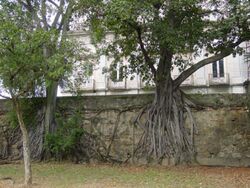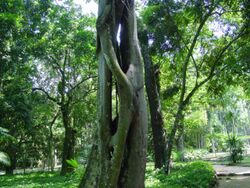Biology:Ficus americana
| West Indian laurel fig | |
|---|---|

| |
| Ficus americana | |
| Scientific classification | |
| Kingdom: | Plantae |
| Clade: | Tracheophytes |
| Clade: | Angiosperms |
| Clade: | Eudicots |
| Clade: | Rosids |
| Order: | Rosales |
| Family: | Moraceae |
| Genus: | Ficus |
| Subgenus: | F. subg. Urostigma |
| Species: | F. americana
|
| Binomial name | |
| Ficus americana Aubl. 1775, conserved name
| |
| Synonyms | |
|
Ficus perforata L. Uncertain names[3] | |
Ficus americana, commonly known as the West Indian laurel fig[4] or Jamaican cherry fig,[5] is a tree in the family Moraceae which is native to the Caribbean, Mexico in the north, through Central and South America south to southern Brazil . It is an introduced species in Florida, USA. The species is variable; the five recognised subspecies were previously placed in a large number of other species.


Description
Ficus americana is a shrub or tree which grows up to 30 m (100 ft) tall.[6]
Taxonomy
With about 750 species, Ficus (Moraceae) is one of the largest angiosperm genera (ranked the 31st largest by David Frodin of Chelsea Physic Garden).[7] Ficus americana is classified in the subgenus Urostigma (the strangler figs) and the section Americana.[2] Recent molecular phylogenies have shown that subgenus Urostigma is polyphyletic, but have strongly supported the validity of section Americana as a discrete group (although its exact relationship to section Galoglychia is unclear).[8]
Both Aublet and Linnaeus published descriptions of this species in 1775, basing them on an illustration of Charles Plumier's published posthumously in Plantarum americanarum, quas olim Carolus Plumierus detexit (Amsterdam, 1755–1760). There is uncertainty was to which version was published first; since the first-published description has priority, there was confusion as to which was the proper name for the species—F. americana Aubl. or F. perforata L. To resolve this, Cornelis Berg proposed in 2003 that Aublet's name be conserved over Linnaeus', since it was more widely used.[9] This proposal was accepted "after lengthy discussion".[10]
Five subspecies are currently recognised: F. americana Aubl. subsp. americana, F. americana Aubl. subsp. andicola (Standl.) C.C. Berg, F. americana Aubl. subsp. greiffiana (Dugand) C.C. Berg, F. americana Aubl. subsp. guianensis (Desv.) C.C. Berg, and F. americana Aubl. subsp. subapiculata (Miq.) C.C. Berg.[2]
Reproduction
Figs have an obligate mutualism with fig wasp (Agaonidae); figs are only pollinated by fig wasps, and fig wasps can only reproduce in fig flowers. Generally, each fig species depends on a single species of wasp for pollination. The wasps are similarly dependent on their fig species in order to reproduce.
Figs in section Americana of subgenus Urostigma are pollinated by wasps in the genus Pegoscapus. Pegoscapus clusiifolidis was described from Ficus clusiifolia[11] (a synonym of F. americana). Another study refers to P. insularis as the pollinator of F. perforata [12] (another synonym of F. americana). That study also found that P. insularis represented a cryptic species complex.[12]
Distribution
Ficus americana is found throughout the Caribbean, from the Bahamas south to Trinidad and Tobago. It occurs in Mexico, Guatemala, Belize, Honduras, Nicaragua, El Salvador, Costa Rica, Panama, Colombia, Venezuela, Guyana, Suriname, Ecuador, Peru, Bolivia and Brazil .[2] It has been introduced to Florida, USA and has escaped from cultivation in Miami-Dade County.[4]
Ecology
Figs are sometimes considered to be potential keystone species in communities of fruit-eating animals; their asynchronous fruiting patterns may cause them to be important fruit sources when other food sources are scarce.[13] At Tinigua National Park in Colombia Ficus americana was an important fruit producer during periods of fruit scarcity in two of three years. This led Colombian ecologist Pablo Stevens to consider it a potential keystone species at that site.[14]
The interaction between figs and fig wasps is especially well-known (see section on reproduction, above). In addition to their pollinators, Ficus species are exploited by a group of non-pollinating chalcidoid wasps whose larvae develop in its figs. Both pollinating and non-pollinating wasps serve as hosts for parasitoid wasps.[15] In addition to Pegoscapus pollinators, non-pollinating wasps belonging to the genera Heterandrium, Aepocerus and Idarnes were found in F. americana figs in Brazil.[11]
References
- ↑ Botanic Gardens Conservation International (BGCI); IUCN SSC Global Tree Specialist Group (2019). "Ficus americana". IUCN Red List of Threatened Species 2019: e.T143276748A143296470. doi:10.2305/IUCN.UK.2019-1.RLTS.T143276748A143296470.en. https://www.iucnredlist.org/species/143276748/143296470. Retrieved 11 December 2022.
- ↑ 2.0 2.1 2.2 2.3 2.4 Berg, C.C. (2007). "Proposals for treating four species complexes in Ficus subgenus Urostigma section Americanae (Moraceae)". Blumea 52 (2): 295–312. doi:10.3767/000651907X609034. http://www.repository.naturalis.nl/document/565073.
- ↑ Berg notes: "The quality of the types for [these] names ... is such that their identity remains uncertain."
- ↑ 4.0 4.1 "Ficus americana Aublet, Hist. Pl. Guiane. 952. 1775.". Flora of North America. eFloras.org. http://www.efloras.org/florataxon.aspx?flora_id=1&taxon_id=233500646.
- ↑ USDA, NRCS. "Ficus americana Aubl.". The PLANTS Database. National Plant Data Center, Baton Rouge, LA 70874-4490 USA. http://plants.usda.gov/java/profile?symbol=FIAM.
- ↑ DeWolf, Gordon P., Jr. 1960. Ficus (Tourn.) L. In Lorin I. Nevling, Jr., Flora of Panama. Part IV. Fascicle II. Annals of the Missouri Botanical Garden, 47 (2):81–203
- ↑ Frodin, David G. (2004). "History and concepts of big plant genera". Taxon 53 (3): 753–76. doi:10.2307/4135449.
- ↑ Rønsted, N.; Weiblen, G. D.; Clement, W. L.; Zerega, N. J. C.; Savolainen, V. (2008). "Reconstructing the phylogeny of figs (Ficus, Moraceae) to reveal the history of the fig pollination mutualism". Symbiosis 45 (1–3): 45–56. http://geo.cbs.umn.edu/RonstedEtAl2008a.pdf.
- ↑ Berg, Cornelis C. (May 2003). "(1587–1590) Proposals to conserve the names Ficus citrifolia against F. caribaea, F. maxima with a conserved type, F. aurea against F. ciliolosa, and F. americana against F. perforata (Moraceae)". Taxon 52 (2): 368–370. doi:10.2307/3647421.
- ↑ Brummitt, R.K. (November 2005). "Report of the Committee for Spermatophyta: 57". Taxon 54 (4): 1093–1103. doi:10.2307/25065499.
- ↑ 11.0 11.1 Schiffler, Gustavo; Celso Oliviera Azevedo; Ricardo Kawada (2002). "Agaonidae (Hymenoptera, Chalcidoidea) associados a sicônios de Ficus clusiifolia (Moraceae) da restinga de Três Praias, Guarapari, Espírito Santo, Brasil". Boletim do Museu de Biologia Mello Leitão. Nova Série 14: 5–12. http://www.nhm.ac.uk/resources/research-curation/projects/chalcidoids/pdf_X/SchiffAzKa2002.pdf.
- ↑ 12.0 12.1 Molbo, Drude; Carlos A. Machado; Jan G. Sevenster; Laurent Keller; Edward Allen Herre (2003). "Cryptic species of fig-pollinating wasps: Implications for the evolution of the fig–wasp mutualism, sex allocation, and precision of adaptation". Proceedings of the National Academy of Sciences of the United States of America 100 (10): 5867–72. doi:10.1073/pnas.0930903100. PMID 12714682. Bibcode: 2003PNAS..100.5867M.
- ↑ Terborgh, John (1986). "Keystone plant resources in the tropical forests". in Soulé, M.E.. Conservation Biology: The Science of Scarcity and Diversity. Sunderland, Massachusetts: Sinauer Associates. pp. 330–344. ISBN 978-0-87893-795-0.
- ↑ Stevenson, Pablo (2005). "Potential Keystone Plant Species for the Frugivore Community at Tinigua Park, Colombia". in J. Lawrence Dew. Tropical Fruits and Frugivores: The Search for Strong Interactors. Springer Netherlands. pp. 37–57. doi:10.1007/1-4020-3833-X. ISBN 978-1-4020-3833-4.
- ↑ Kjellberg, Finn; Emmanuelle Jousselin; Martine Hossaert-McKey; Jean-Yves Rasplus (2005). "Biology, ecology and evolution of fig-pollinating wasps (Chalcidoidea, Agaonidae)". in A. Raman. Biology, Ecology, and Evolution of Gall-inducing Arthropods. Enfield (NH) USA, Plymouth, UK: Science publishers, Inc.. pp. 539–572. ISBN 978-1-57808-262-9. http://www.cefe.cnrs.fr/coev/pdf/fk/Kjellberg2005book.pdf.
Wikidata ☰ Q3585536 entry
 |


